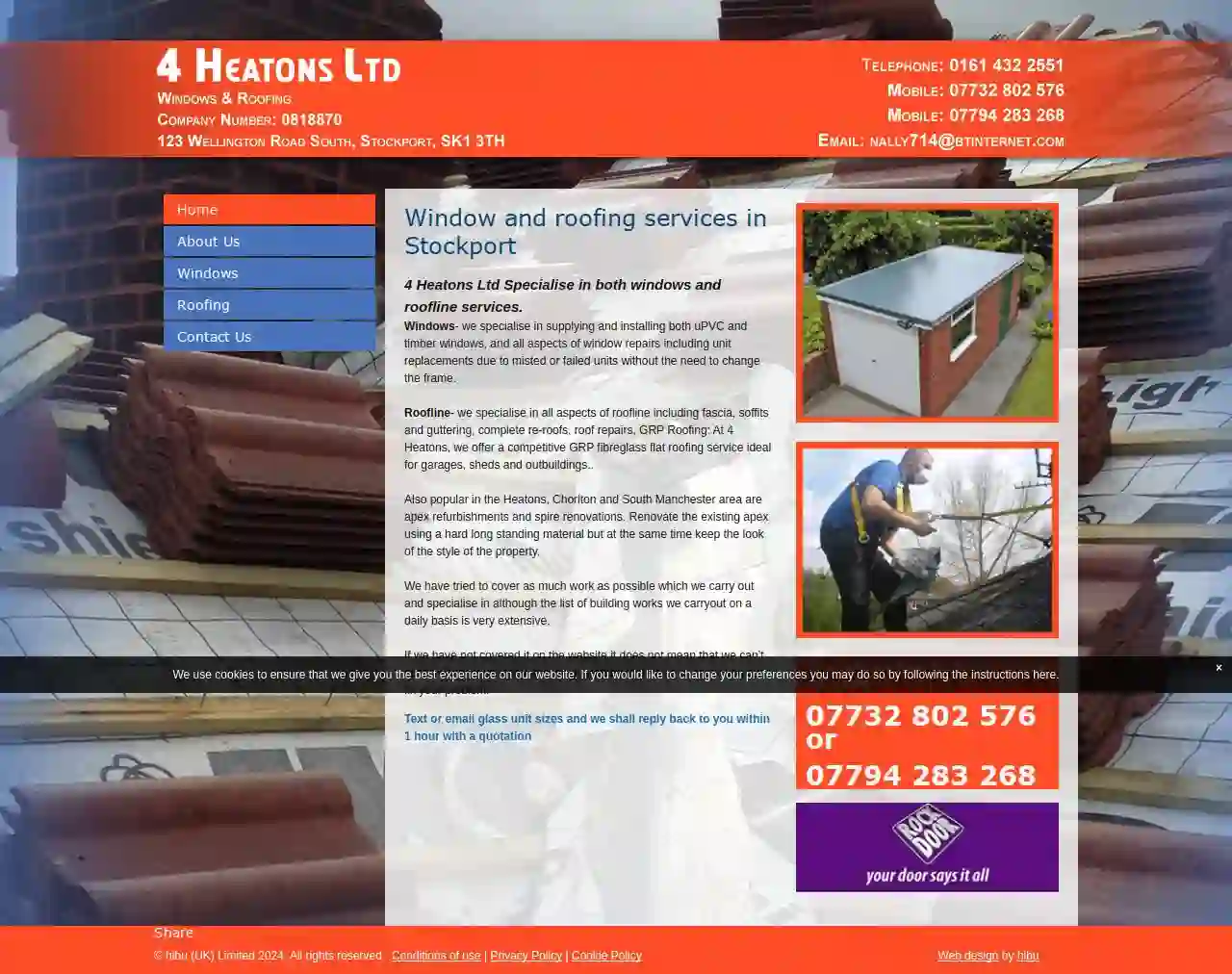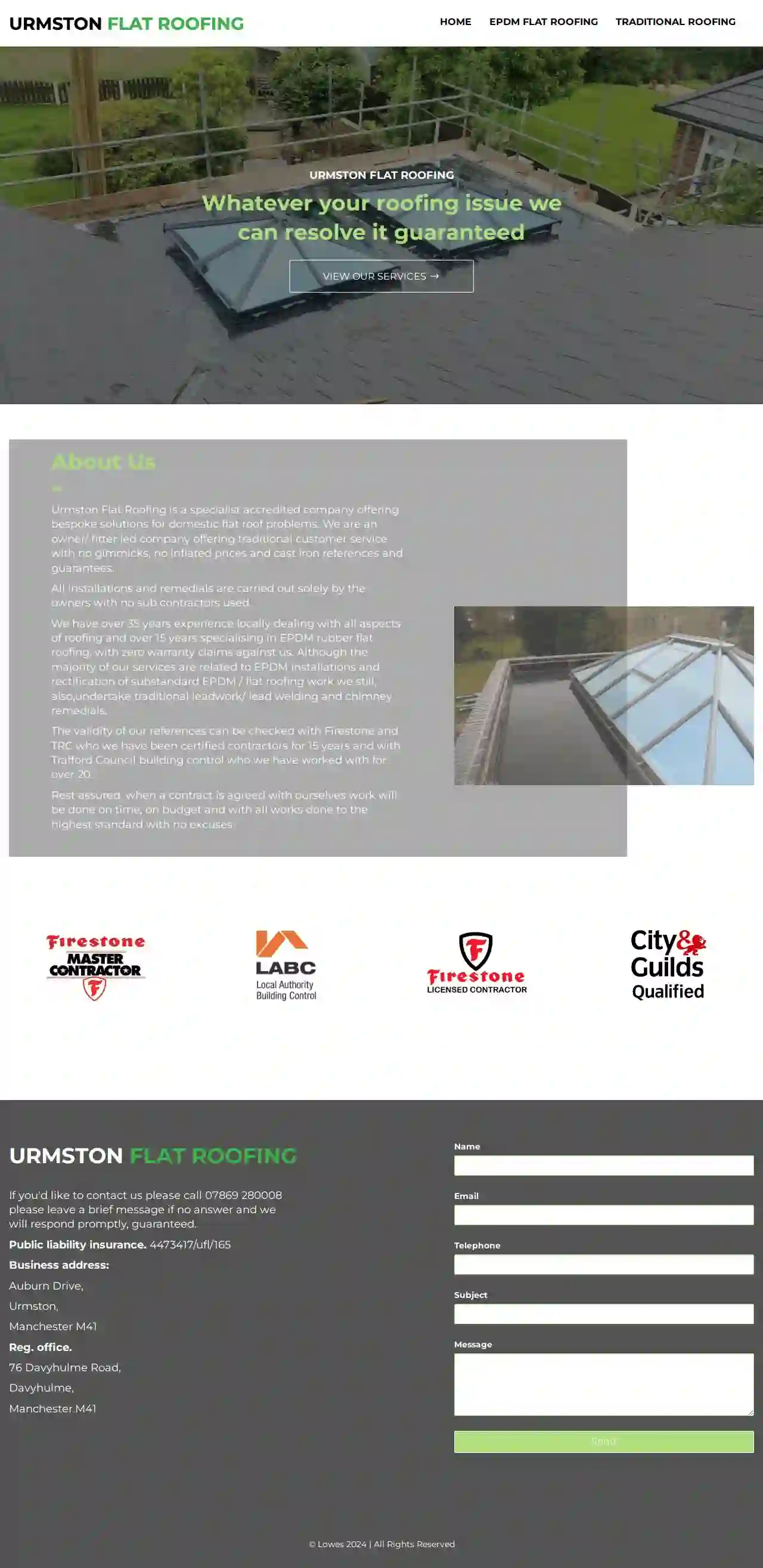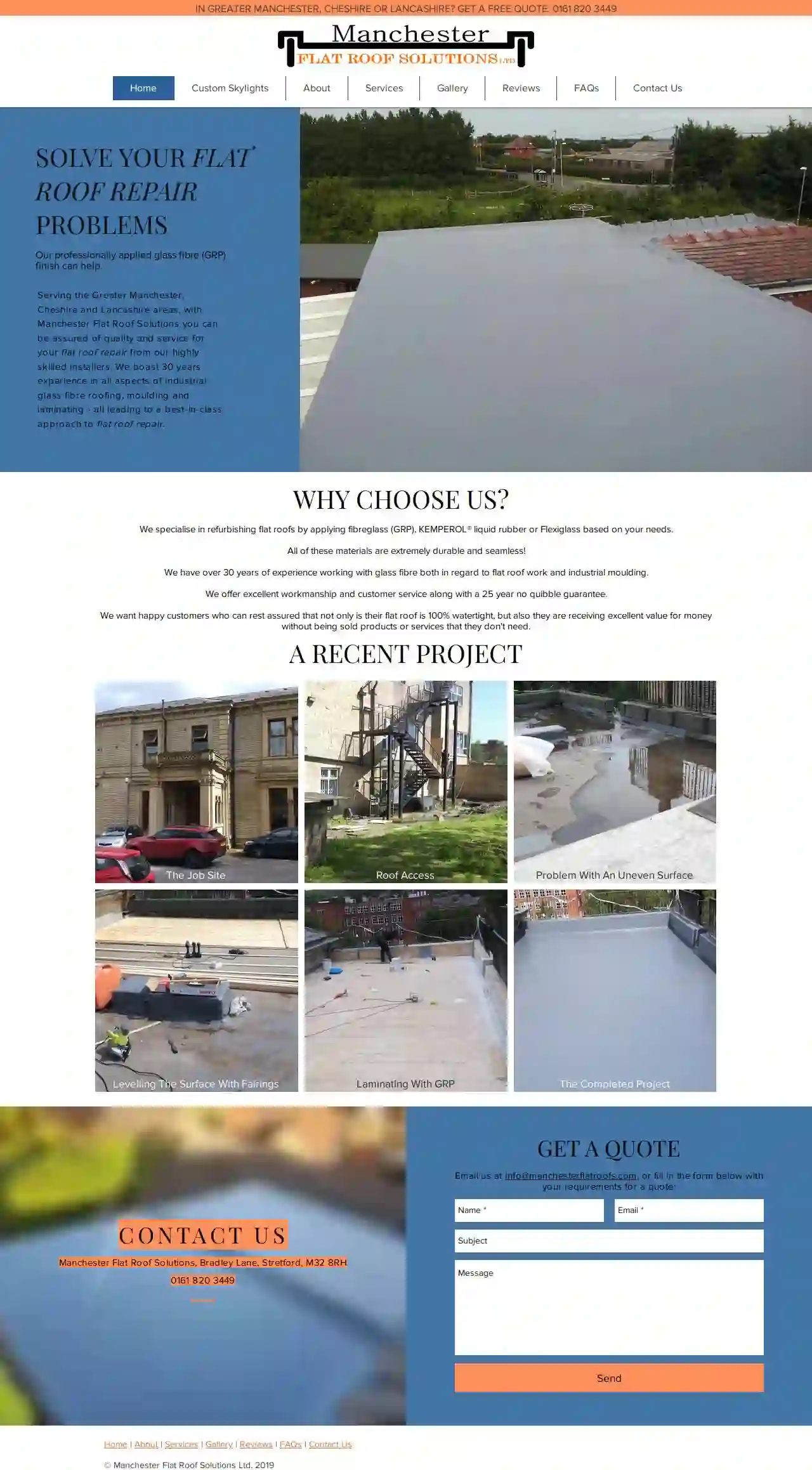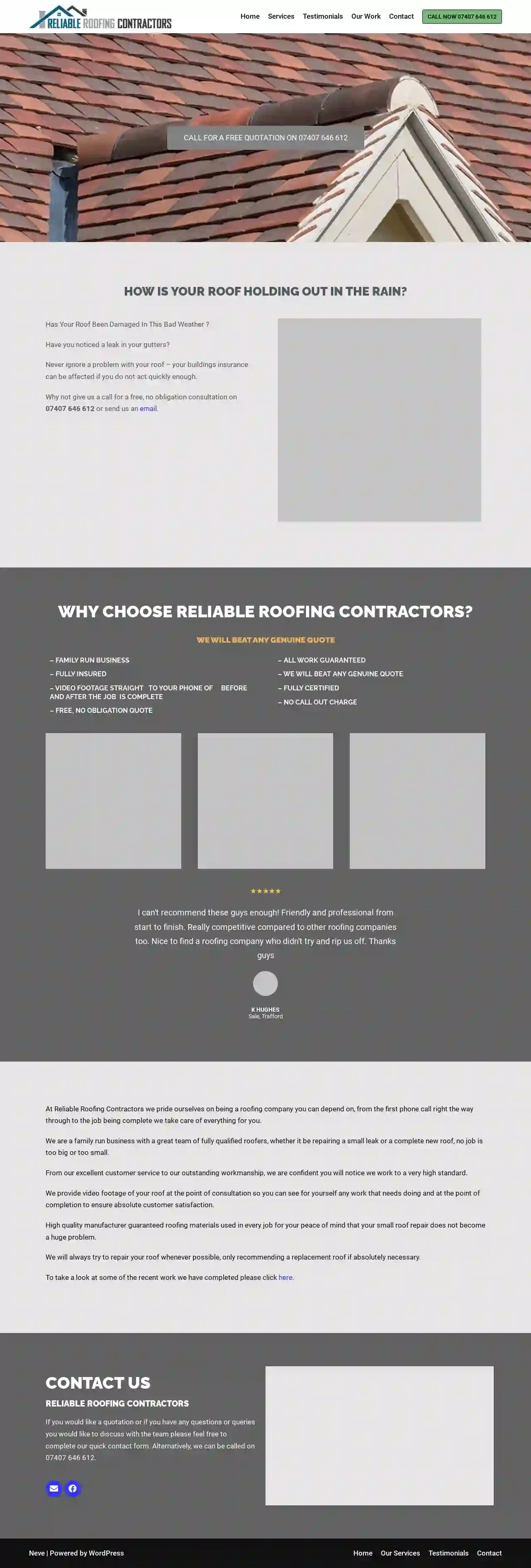Roofing Companies Denton
Find the best Roofers in Denton
Receive multiple Roofing Service quotes for your project today! Compare profiles, reviews, accreditations, portfolio, etc... and choose the best offer.

Finn G M
52 reviews6 Kingswood Grove, Stockport, SK5 6SP, GBGM Finn Roofing & Building Services is a company dedicated to providing top-notch roofing services to protect your property and add value to your investment. With over 25 years of experience, they are experts in all aspects of roofing repairs and services, guaranteeing the highest quality service and ensuring customer satisfaction. Their services include complete re-roofs, brickwork and pointing, chimney repairs, re-slating and tiling, dry verge systems, skylights, UPVC fascia, soffits and guttering, flat roofs, and leadwork. They specialize in traditional timber and cast iron guttering and offer reliable and efficient services for all your roofing needs. GM Finn Roofing Repairs focuses on providing professional roofing repair services, handling both minor and substantial repairs with expertise. They use the best materials and equipment to ensure high-quality workmanship and attention to detail. The company offers a range of services including leadwork, roof repairs, chimney stack services, soffits and fascias, and guttering. They pride themselves on their responsiveness, expertise, and quality workmanship. GM Finn Roofing guarantees the best service and materials, providing no-obligation free quotes and committed to exceeding customer expectations.
- Services
- Why Us?
- Testimonials
- Gallery
Get Quote
A & E Roofing and Joinery
Whitwell, GBSouth Yorkshire Roofing Network is a network of roofing professionals serving Whitwell and surrounding areas. We offer a wide range of roofing services for both residential and commercial customers, including roof repairs, flat roofing, guttering, fascias & soffits, and more. Our members are experienced and qualified roofers who are committed to providing high-quality workmanship at competitive prices. We understand that your roof is a vital part of your home or business, and we take pride in providing reliable and durable solutions to meet your needs. Whether you have a small leak or a major roof replacement, our team can help. Contact us today for a free quote.
- Services
- Why Us?
- Gallery
Get Quote
4 Heatons Windows and Roofing
4.511 reviews123 Wellington Road South, Stockport, SK1 3TH, GB4 Heatons Ltd has been established as a Limited Company since 2007, although its Managing Director John has a vast number of years of experience in the trade; in fact he has around 15 Years experience doing what he does today.John started up a Limited Company specialising in roofing and windows because he thoroughly enjoys what he does and he is talented at it, with a keen eye for detail and always seems to know what the customer wants.The company has built up over the years on a lot of recommendations from previous customers who have been happy with the works and services which we have provided. Customer satisfaction is our objective! Our customer base is primarily the Heatons area and South Manchester.We also have specialist Tradesmen that works along side us if need be such as electricians, plasterers, plumbers, decorators and gas fitters.4 Heatons Ltd carry out an extensive amount of building works from minor repairs such as replacement of a window handle to erection of conservatories and full replacement double glazing. Please ask for more details.We also carry out out small roof repairs such as patch repairs to full re-roofs. Please as for more details. There is no job too small for us and no job too big!We hope that we have been assistance today and please bear in mind all of our quotes are competitive mainly because we are a small business and can keep our overheads down.Unlike the larger companies who have higher overheads therefore dearer quotes, all of our works come with individual guarantees.Please feel free to browse our website: www.4heatonswindowsandroofing.co.uk Thank you and we hope we can assist with your works.
- Services
- Why Us?
- Our Team
- Gallery
Get Quote
Urmston Flat Roofing
516 reviewsAuburn Drive, Urmston, M41, GBUrmston Flat Roofing is a specialist accredited company offering bespoke solutions for domestic flat roof problems. We are an owner/ fitter led company offering traditional customer service with no gimmicks, no inflated prices and cast iron references and guarantees. All installations and remedials are carried out solely by the owners with no sub contractors used. We have over 35 years experience locally dealing with all aspects of roofing and over 15 years specialising in EPDM rubber flat roofing, with zero warranty claims against us. Although the majority of our services are related to EPDM installations and rectification of substandard EPDM / flat roofing work we still, also, undertake traditional leadwork/ lead welding and chimney remedials. The validity of our references can be checked with Firestone and TRC who we have been certified contractors for 15 years and with Trafford Council building control who we have worked with for over 20. Rest assured, when a contract is agreed with ourselves work will be done on time, on budget and with all works done to the highest standard with no excuses.
- Services
- Why Us?
- Accreditations
- Gallery
Get Quote
AJ Guttering & Roofing
4.25 reviewsSale, GBDRY RIDGE Our Roll-Out Dry Ridge universal systems securely fixes the ridge tiles onto a roof, protecting them from wind up-lift and rain penetration. There is no need for mortar, making the job of fixing the ridge quick, easy and clean, as well as making it possible during frosts and other adverse weather conditions. No more pointing and cement problems etc !!!!! DRY VERGE Over time the concrete render between tiles and roof can deteriorate causing damp and making your roof space colder This product protects for years to come FASCIAS & SOFFITS Improve the appearance of your property and replace old wood with new low maintenance Upvc - that will last and protect for years to come - reduce storm Damage - and create peace of mind FREE ESTIMATES FREE ROOF INSPECTIONS FREE ROOFING ADVICE CALL US YOUR WELCOME CONTACT THE ROOF RESCUE TEAM FOR FAST SERVICES BEFORE STORM DAMAGE SETS IN CALL US FAST WE CAN RESCUE YOU FAST Asphalt roofs Chimney repairs Felt roofs Flat roofs grp Roofs EPDM Rubber Flat Roofs Garage roofs Guttering & downpipes Lead roofs Lead work Leaking roofs – all types New roofs & re-roofs Pitched roofs Pointing Porch roofs Roof flashing Roof lightsRoof repairs Roof window repairs & installs Roofing carpentry Roofing inspections & reports Roofing insulation Shed roofs Slate & tiled roofs Soffits, fascias & cladding Valleys & gullies Upvc Fascias Soffits and Gutters Chimney Work, Rendering , Pointing, Ridge tiles NEW ROOFS Using quality materials to withstand the Uk weather our new roofs are fully guaranteed protecting your property. We can provide new batons joists and roofing felt and all rubbish is removed Leaving your property clean and tidy Peace of mind for years to come FLAT ROOFS New build repairs and maintenance flat roofs can be in several types traditional mineral, rubber EPDM and glass fibre …old installations often Create problems but with modern materials solutions are always at hand And are trouble free lasting for years. Often it can be cheaper to simply re-coat - peace of mind for years to come ROOF REPAIRS …our team can inspect and advise ..helping you protect your property - Wind rain frost and snow - Storm damage …extreme uk weather .. we can protect - from small leaks to a complete overhaul means job done ! ….safe
- Services
- Why Us?
- Gallery
Get Quote
Manchester Flat Roof Solutions Ltd.
4.414 reviewsBradley Lane, Stretford, M32 8RH, GBServing the Greater Manchester, Cheshire and Lancashire areas, Manchester Flat Roof Solutions provides quality and service for your flat roof repair from our highly skilled installers. We boast 30 years experience in all aspects of industrial glass fibre roofing, moulding and laminating - all leading to a best-in-class approach to flat roof repair. We specialise in refurbishing flat roofs by applying fibreglass (GRP), KEMPEROL® liquid rubber or Flexiglass based on your needs. All of these materials are extremely durable and seamless! We have over 30 years of experience working with glass fibre both in regard to flat roof work and industrial moulding. We offer excellent workmanship and customer service along with a 25 year no quibble guarantee. We want happy customers who can rest assured that not only is their flat roof is 100% watertight, but also they are receiving excellent value for money without being sold products or services that they don't need.
- Services
- Why Us?
- Gallery
Get Quote
P N W Roofing Ltd
51 reviewsBuckley, 35 Megs Lane, CH7 2AE, GBPolyroof is the current market leader in fiberglass roofing. We offer a professional service to all areas of the flat roofing market, including private and commercial projects, new builds and renovation work, covering the northwest and north Wales area. With over 16 years of experience, we have provided Polyroof flat roofing services for private and commercial customers throughout Cheshire, Wrexham and North Wales. We've got you covered with our suitable solutions for both refurbishment and new build applications, waterproofing everything from porches and dormers to extensions and garage roofs. Our fully trained and approved Polyroof installation contractors can provide attractive, waterproof, low maintenance and cost effective flat roofing solutions.
- Services
- Why Us?
- Accreditations
- Our Team
- Gallery
Get Quote
ADM Roofing
10 Ferndale, Hyde, SK14 4GP, GBAt ADM Roofing, we have a combined 30+ years of roofing and construction experience coming from various backgrounds. We are a specialist team working within the roofing industry in Manchester for over 20 years, combining creativity with new ideas as well as a fresh approach for all our clients needs. We only provide high standard roofing work with quality roofing material. By using the latest products on the market and the most advanced techniques, ADM Roofing guarantees the highest specification roof coverings. Based in Hyde (Manchester), we pride ourselves on a reliable and honest service to each of our customers. Our staff are experienced tradesmen with skill sets in all types of roofing projects including Roofing, Slating, Felting, Tiling, Dormers, Velux Windows and Guttering, just to name few of our available services.
- Services
- Why Us?
- Our Team
- Testimonials
- Gallery
Get Quote
Reliable Roofing Contractors
GBAt Reliable Roofing Contractors, we're a family-run business dedicated to providing top-notch roofing services you can trust. Our team of fully qualified roofers is ready to handle any project, big or small, from repairing a minor leak to installing a brand new roof. We pride ourselves on our exceptional customer service and outstanding workmanship, ensuring your complete satisfaction every step of the way. We understand the importance of transparency, which is why we provide video footage of your roof during both the consultation and completion stages. This allows you to see exactly what needs to be done and the quality of our work firsthand. We use only high-quality, manufacturer-guaranteed roofing materials in every job, giving you peace of mind that your roof repair won't become a bigger problem down the line. We always prioritize repairs whenever possible, recommending a replacement roof only when absolutely necessary. To see examples of our recent work, please visit our 'Our Work' page. For a free, no-obligation quote or to discuss your roofing needs, don't hesitate to contact us. You can reach us by phone at 07407 646 612 or fill out our quick contact form.
- Services
- Why Us?
- Testimonials
- Gallery
Get Quote
K.H. Roofing
514 reviewsRegency Court, Deansgate, 62-66 Regency Court, Manchester, M3 2EN, GBK.H. ROOFING is a family-run roofing contractor based in Manchester, serving the North West region for the past 10 years. We pride ourselves on providing top-quality roofing services at affordable prices, with a focus on three key targets: efficiency, competitive pricing, and exceptional workmanship. Our commitment to customer satisfaction is evident in our reputation for consistently happy clients, with much of our business stemming from word-of-mouth referrals. We understand that a roof is a crucial part of your home, and we strive to ensure our customers have peace of mind. Our experienced team is available 24/7 to address any concerns and provide prompt assistance, whether it's a minor repair or a major project. We offer a wide range of services, including free consultations, repairs, maintenance, flat roof installation, slating and tiling, roof replacement, and fascia and guttering services. We use high-quality materials and guarantee our workmanship for 15 years, with some roofs lasting up to 50 years with proper maintenance.
- Services
- Why Us?
- Accreditations
- Our Team
- Testimonials
- Gallery
Get Quote
Over 12,314+ Roofers onboarded
Our roofing pros operate in Denton & surroundings!
Roofyng.co.uk has curated and vetted Top Roofing Businesses in and around Denton. Find the most reliable pro today.
Frequently Asked Questions About Roofing Companies
- Home Improvement Loans: Offered by banks or credit unions.
- Home Equity Loans or Lines of Credit: Use your home's equity as collateral.
- Government Programs: Check for energy efficiency rebates or grants.
- Contractor Financing: Some roofing companies offer financing plans.
- Age: If your roof is nearing or exceeding its expected lifespan, it's wise to consider replacement.
- Multiple Leaks: Several leaks or leaks that reappear after repairs suggest a widespread problem.
- Extensive Damage: Large areas of damaged, missing, or deteriorated roofing materials might be too costly or difficult to repair effectively.
- Sagging or Structural Issues: Sagging, deflection, or other structural issues indicate a compromised roof that needs replacement.
- Granule Loss (Asphalt Shingles): Significant granule loss indicates weathering and reduced protection.
- Curling or Buckling Shingles: Signifies age or improper ventilation.
- Increased Energy Bills: A poorly insulated roof can lead to higher heating and cooling costs.
- Roof size and complexity
- Roofing material chosen
- Local labor costs
- Accessibility of the roof
- Removal of existing roofing
- Additional features (skylights, chimneys, etc.)
How can I get financing for a new roof?
What are the signs that my roof needs to be replaced?
What is fascia, and why is it important?
How much does a new roof cost in the UK?
How can I get financing for a new roof?
- Home Improvement Loans: Offered by banks or credit unions.
- Home Equity Loans or Lines of Credit: Use your home's equity as collateral.
- Government Programs: Check for energy efficiency rebates or grants.
- Contractor Financing: Some roofing companies offer financing plans.
What are the signs that my roof needs to be replaced?
- Age: If your roof is nearing or exceeding its expected lifespan, it's wise to consider replacement.
- Multiple Leaks: Several leaks or leaks that reappear after repairs suggest a widespread problem.
- Extensive Damage: Large areas of damaged, missing, or deteriorated roofing materials might be too costly or difficult to repair effectively.
- Sagging or Structural Issues: Sagging, deflection, or other structural issues indicate a compromised roof that needs replacement.
- Granule Loss (Asphalt Shingles): Significant granule loss indicates weathering and reduced protection.
- Curling or Buckling Shingles: Signifies age or improper ventilation.
- Increased Energy Bills: A poorly insulated roof can lead to higher heating and cooling costs.
What is fascia, and why is it important?
How much does a new roof cost in the UK?
- Roof size and complexity
- Roofing material chosen
- Local labor costs
- Accessibility of the roof
- Removal of existing roofing
- Additional features (skylights, chimneys, etc.)